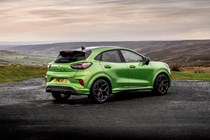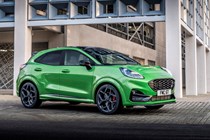Ford Puma ST review
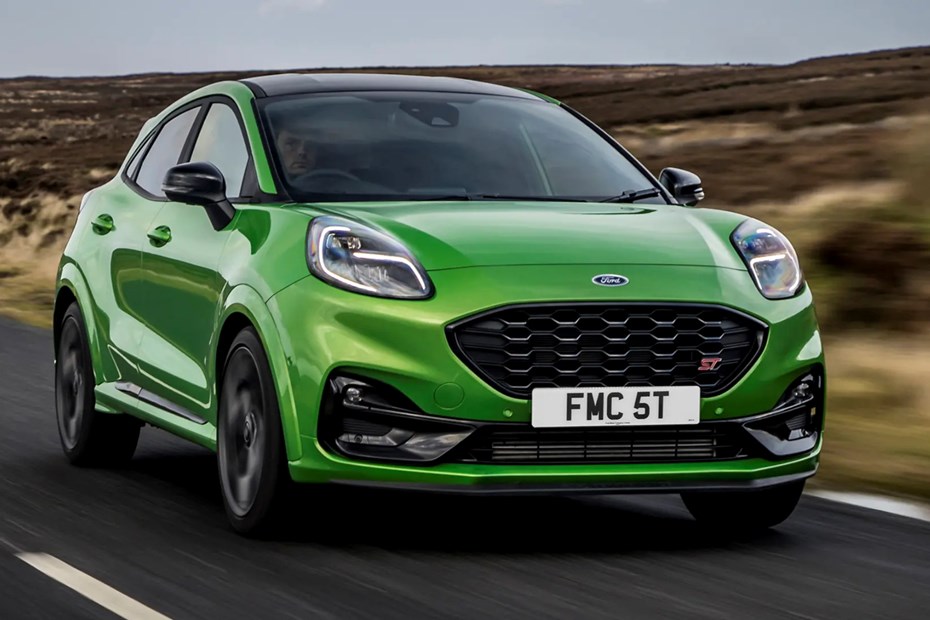
At a glance
| Price new | £31,515 - £32,465 |
|---|---|
| Used prices | £15,092 - £27,440 |
| Road tax cost | £190 |
| Insurance group | 22 |
Get an insurance quote with

|
|
| Fuel economy | 42.8 mpg |
| Miles per pound | 6.3 |
| View full specs for a specific version | |
Available fuel types
Petrol
Pros & cons
- Amazing to drive
- As practical as a regular Puma
- Good value
- Harsh, unforgiving suspension
- Not as fast as a Hyundai Kona N
- Frog-like looks aren't for everyone
Ford Puma ST rivals
Overview
Is the Ford Puma ST any good?
The Puma is a revered and award-winning SUV. The brawnier Ford Puma ST turns things up to 11 thanks to engines more normally found in hot hatchbacks such as the recently discontinued Fiesta ST.
As a high-performance crossover, its closest rival is the Hyundai Kona N. But bigger and more expensive cars such as the Cupra Formentor and Volkswagen T-Roc R may also be on similar shopping lists.
And yes, the Ford Puma ST is very good. It’s a tiny tearaway designed to offer the driving thrills of a pocket rocket in a slightly more practical package.
It excels at both of those points. On the road it’s feisty and great fun to drive. The steering is sharp, the engine is boosty and the ride is firm, occasionally compromised by its stiff suspension and large wheels that can patter over urban corrugations.
It’s just as practical as a regular Puma though, and retains Ford’s 80-litre waterproof storage box in the boot. It’s an unusual feature and one that’ll draw crowds if you want an impromptu drinks cooler at an outdoor event.
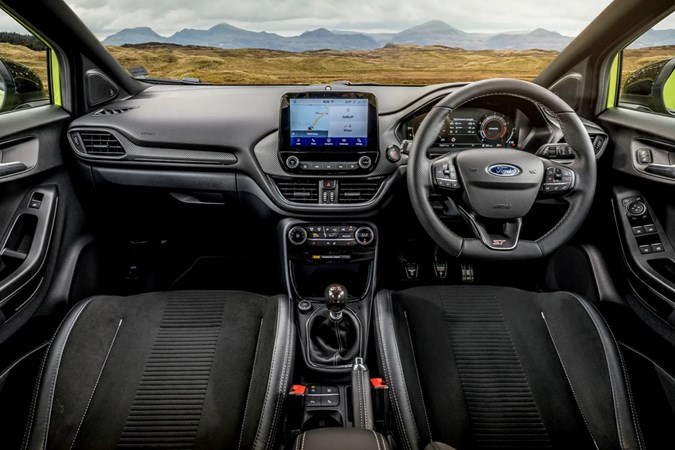
What’s it like inside?
It’s largely the same as the regular Ford Puma in here. Improvements include Recaro sports seats and extra dollops of gloss black paint to lend a more sporting ambience.
The seats have six-way adjustment and provide a good choice of seating positions. You sit higher than in a supermini, but still lower than you would in a small SUV.
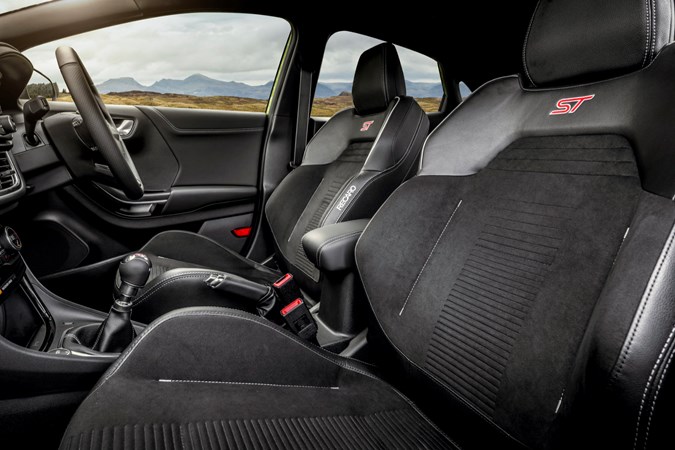
Up front storage is merely okay. The glovebox is big but the door bins aren’t, plus the cupholders are right next to the handbrake and may struggle to accommodate the trend for supersized coffee receptacles.
The infotainment is the same as the regular Puma’s. So it gets an 8.0-inch display with Apple CarPlay and Android Auto and Ford’s logical, easy-to-use touchscreen and menus.
In the rear there’s just about enough room for a couple of kids, but the Puma ST remains a pretty narrow car. So three adults in the back is a no-no for long journeys.

Boot space remains the same as a regular Puma, which is a good thing. It’s bigger than the one found in the Kona N, plus it has Ford’s Megabox system, essentially an 80-litre mini boot under the boot floor with a plug hole in the bottom so you can store wet items or even fill it with ice and water to create a makeshift fridge.
What’s it like to drive?
Point the Puma ST towards twisty roads and it’s just as much fun as a Fiesta ST. The steering is more responsive than the standard Puma’s and it makes the ST far easier to play with.
It’s about 100kg heavier than a Fiesta ST. To counter this, the rear suspension is 50% stiffer, and it makes Puma surprisingly resistant to bodyroll in corners.
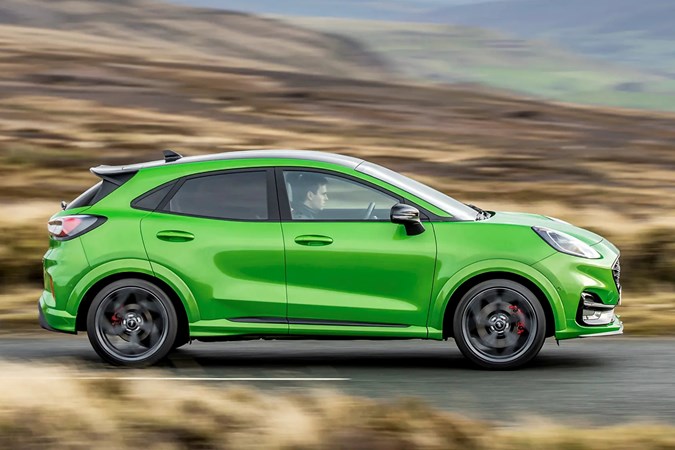
It makes this a fun, agile little pocket rocket. A mechanical limited-slip differential and torque-vectoring do their best to maximise traction under hard acceleration, keeping everything predictable.
The bad news is that it does make the car firm. This is most notable at town speeds. At 20-30 mph it drops hard into potholes and bangs over speed bumps. This is irritating and should be taken into consideration if you regularly do short trips around urban areas. Things improve at motorway speeds and it’s not as uncomfortable or as jolting as the Hyundai Kona N.
The Puma ST comes with a six-speed manual gearbox, which is a joy to use. It’s positive and mechanical, with a firm clutch that’s easy and pleasing to use. The 1.5-litre turbo from the Fiesta ST is largely unchanged. It has 200hp, which is 47hp more than the next most powerful Puma, and continues to drive the front wheels.
New for 2023 is the addition of an automatic Puma ST. It’s unusual in packing an entirely different powertrain from the 1.5 manual: the 1.0-litre Ecoboost is noticeably less brawny, producing 170hp. It includes a fuel-saving mild-hybrid system that the manual car misses out on, and a seven-speed automatic transmission for those who prefer to let the car swap cogs for them.
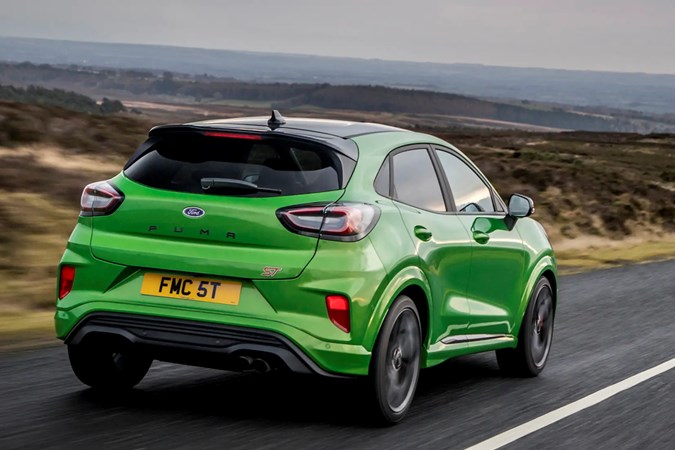
Pick the manual Puma ST for the fastest acceleration: 0-62mph takes just 6.7 seconds, but to be honest even the automatic Puma ST feels rapid with its 7.4sec sprint time.
What models and trims are available?
There’s only one new Puma ST to pick. Simply called the ST, it’s a standalone model. Bespoke features include 19-inch ST alloys, a body kit, red brake calipers, a rear spoiler and a front splitter with Ford Performance embossed on it.
There was also a Ford Puma ST Gold Edition on sale. It was designed in part by Ford’s social media followers via a set of polls. It was limited to 999 cars and included satin gold wheels, gold racing stripes, black paint, gold striped seats and a few bits of carbonfibre inside.
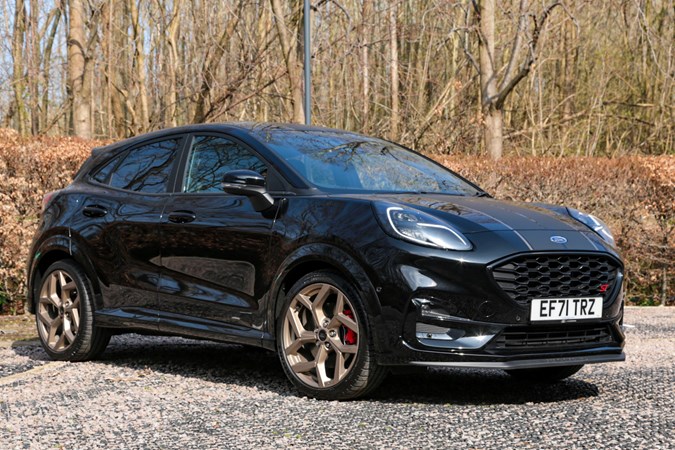
So your only real choice is between manual and automatic transmissions. We rate both gearboxes – you won’t be disappointed if you pick the slower auto and both should easily exceed 40mpg in daily use unless you really do thrash it.
We’d ultimately recommend the faster, fizzier manual if you want to fully exploit your performance crossover.
What else should I know?
The Puma ST is easy enough to understand. Mechanically it’s nearly identical to the now-defunct Ford Fiesta ST, but it adds a bit more practicality to the mix. It’s an interesting new genre of hot hatch – a taller, more family-friendly type of performance car.



